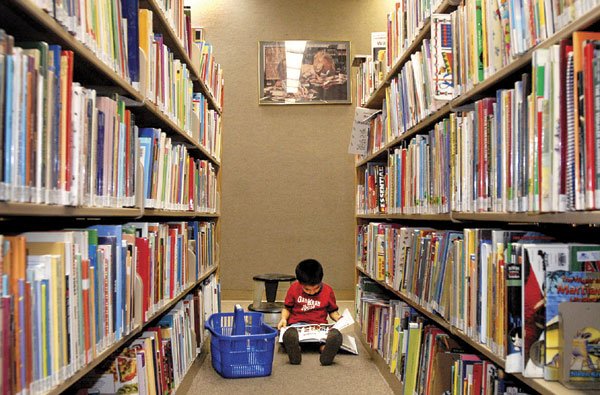Earlier this year, Lani Yoshimura opened the library doors to
find two toddlers on the doorstep, one of which had only recently
learned to walk.
Gilroy – Earlier this year, Lani Yoshimura opened the library doors to find two toddlers on the doorstep, one of which had only recently learned to walk. Yoshimura, suspecting the mother would return, took the toddlers in, set them up with a book and took care of them until their mother came back about eight hours later.
The event, while extreme, was not that bizarre for the Santa Clara County Library, Gilroy branch. As in libraries nationwide, local librarians are functioning in a number of roles, including caretakers for older adults and unattended children. The library has become in many ways a de facto daycare center.
“People sometimes think it’s an appropriate place to deposit their children no matter what the age is,” community librarian Yoshimura said.
Brothers Miguel and Victor Lugo, 12 and 10, are regulars at the library. During the school year, the pair spend three hours twice a week surfing the Internet, reading a book or socializing.
“I come to the library mostly just to get away from the stress of my family,” Miguel Lugo said. “It’s just a place to come and relax, meet friends.”
The brothers hang out until their mother gets off of work about 5:30pm. With school out during the summer, the brothers have sometimes spent more than six hours in the library. They share the facilities with the hundreds of weekly library patrons, including parents camped out in a corner reading a novel, children coloring at foot-high tables, teenagers bobbing to music pumped through headphones and the occasional adult slumped over, asleep in a chair.
When contacted at the doctor’s office where she works, mother Angie Molano declined to comment.
Gilroy librarians are not alone in doubling as babysitters. Libraries nationwide have become an alternative to daycare facilities. In Gilroy, the problem is complicated by daycare’s expense – the average annual cost of childcare in Santa Clara County is more than $10,000 – and scarcity – more than 300 families with more than 500 children are on a waiting list for subsidized county childcare. The library, which does not discriminate among clients, has picked up some of the slack.
While many children might be well behaved, parent absence makes situations where a child acts out more difficult, Yoshimura said. Librarians cannot send the child outside without their parent, but rather must play the role of parent, which distracts from their other duties, such as sorting and checking out books.
In addition, with their workload, librarians cannot always provide adequate care, Yoshimura said.
“We’re so busy that we may not notice the exact situation of every child,” she said. “If you think about what a public park is, the same kind of rules apply to us. The rangers – they don’t see everybody. They don’t necessarily know who belongs to who.”
Librarians have found themselves caring for people in addition to unattended children. Older adults, many of whom have neurological conditions such as Alzheimer’s disease, regularly wander into the library or are left there by friends or relatives. Librarians sometimes recognize the adults and can guide them home, but more often librarians must call police to get the adults home.
With older adults spending hours in the library, medical emergencies are inevitable, Yoshimura said. She can recall multiple instances where she has had to care for people with chest pains, who fainted or are suffering other dire medical needs. The librarians, trained in first aid and true to their form as Jacks of all trades, become impromptu emergency medical technicians.
When a man collapsed on the ground earlier this year, the librarians remained composed. Even as one librarian administered medical aid, the other librarians conducted business as usual.
“We still did reference; we still kept checking out books,” Yoshimura said.
It doesn’t do any good to get frustrated at the additional duties librarians have had to assume, Yoshimura said. Caring for older adults and children, as well as people of all ages in all situations, is integral to running a public facility, she said.
“It’s a part of life, it’s a part of the community,” she said. “We just deal with it.”











